We take a look back at an exceptional adventure. The one recounted in Woodrow Wilson Sayre's Four Men Against Everest, published by Flammarion in 1965. In 1962, ten years after their victory on Everest's South Face, four American adventurers decided to attempt an ascent of Everest via the North Face. They hoped it would remain untouched. But Tibet, under Mao, remains as inaccessible as ever. Without permits, without Sherpas, without oxygen, they set off anyway. The expedition, which went completely unnoticed, was described by the great Eric Shipton himself as a "feat". In its model of lightness and independence, it foreshadowed that of Reinhold Messner. A story to be discovered here.
This week, we return to an exceptional adventure. The one recounted in Woodrow Wilson Sayre's Four Men Against Everest, published by Flammarion in 1965. In 1962, ten years after their victory on Everest's South Face, four American adventurers decided to attempt an ascent of Everest via the North Face. They hoped it would remain untouched. But Tibet, under Mao, remains as inaccessible as ever. Without permits, without Sherpas, without oxygen, they set off anyway.
The expedition, which went completely unnoticed, was described by the great Eric Shipton himself as a "feat". In its model of lightness and independence, it foreshadowed that of Reinhold Messner. A story to be discovered here.
See all our climbs above 8,000 meters.
A philosophy teacher with a dream
1961-1962: difficult years for Uncle Sam. President Kennedy, freshly elected, engages the United States in a hopeless struggle in Vietnam; the CIA prepares the disastrous invasion of Cuba's Bay of Pigs; and Yuri Gagarin, the first man sent into space by the Soviet communists, outwits NASA.
In 1960, Norman Dyrenfurth, film-maker on the Swiss expeditions (Everest in autumn 1952 and Dhaulagiri in spring 1960), naturalized as an American, applied for a permit to climb Everest on behalf of the USA. On May 10, 1961, the Nepalese authorities granted the USA the long-awaited permit to climb Everest in the spring of 1963.
Naturally, Norman Dyrenfuth was to be the "boss". The goal: the interminable 9 km long West Ridge, on the border with Tibet. The honor of the Star-Spangled Banner is at stake. Nothing can stop the steamroller of almighty America.
Yes, but...
Woodrow Wilson Sayre, grandson of President Wilson, a worthy professor of philosophy in Boston and an amateur mountaineer in his spare time, set out as a teenager to climb Everest via the north face. An inveterate romantic, certainly an avid reader of Thoreau (the American JJ Rousseau), he saw himself following in the footsteps of Mallory and Irvine. During his university years, he met Norman Hansen. Sayre's enthusiasm spread like wildfire. They decide to climb Everest together. If they succeed, they'll burn the bridges of Norman Dyrenfuth and his three-hundred-thousand-dollar expedition.
Success at McKinley gives them wings
In 1954, as part of their training, they set out to climb Alaska's Mount McKinley (6,190 m ), the highest peak in the United States, located in the heart of the eponymous national park. To climb it, you have to show your credentials. The administration has a watchful eye on safety. A rope party of at least four men, duly equipped and experienced, with provision, if necessary, for a rescue team of four other climbers. There are two of them, poorly equipped and inexperienced. No matter. Two visiting students form the necessary quartet. In Anchorage, they convince a few barflies to come to their aid, just in case...
With the administration bamboozled, they set off. Thirty days of total autonomy. And as luck favors the bold, they succeeded without any particular difficulty. The weather conditions at Mckinley, close to the Arctic, are as good as those at Everest. So they can set off for the Roof of the World. CQFD.
1962: from dream to reality
On May 25, 1960, the Chinese reached the summit of Everest via the north face. Incredible as it may seem today, the Western alpine community of the time was unaware of this. There are rumours. Two climbers, members of a Chinese expedition, reached the summit by night... No proof. No one believed it. For Sayre and Hansen, in 1961, the ascent of the North Face had yet to be completed.
In 1961, Woodrow Wilson Sayre was 42 years old. Norman Hansen, now a lawyer, was 38. It was now or never. The departure date was set for February 1962. Exactly one year before Norman Dyrenfurth's official expedition.
Asking the Chinese Communists for permission to climb Everest? No need to think about it. In fact, it would have to be possible to come incognito from Nepal. An in-depth study of the maps and accounts of the first ascents shows that a passage does exist. On the border with Tibet, between Pumori (7,165 m) and Gyachung Kang (7,952 m), a gap at 5,900 m, the Nup La, was crossed by Sir Edmund Hillary and George Lowe during the British Everest reconnaissance expedition of 1952.
They will follow the same route. At this altitude, they hope, there is little risk of encountering a Chinese patrol...
But you still need to be able to approach Everest from Nepal. The Nepalese authorities issued the 1962 Everest permit to the Indians. The 1963 permit was issued to Americans. No chance for Sayre. The virgin peak of Gyachung Kang provided the ideal excuse to apply for another permit from the Nepalese authorities. The passage to Tibet was clandestine.
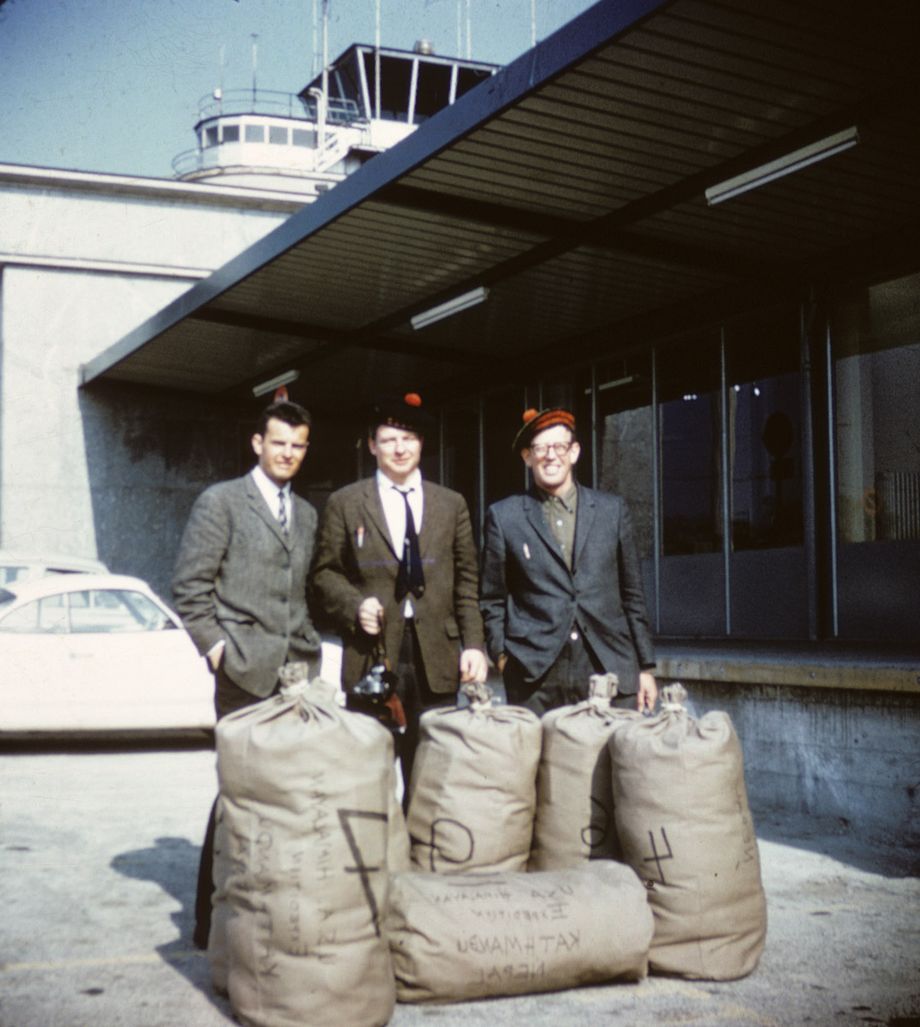
Arrival in Nepal © Hans-Peter Duttle
The expedition will be light or it won't be
To carry out their high-altitude smuggling project, they couldn't be bothered with troublesome witnesses. Beyond the Gyachung Kang base camp, they will do without Sherpas. As for the hypothesis of using oxygen (like all previous victorious expeditions), between the weight and the artificial aid aspect, judged unworthy of true mountaineering, they will also do without it. So they set off without permits, without Sherpas and without oxygen. As a result, the ascent will have to be made in small numbers, without fixed camps, carrying all their equipment on their backs. McKinley style. With a minimal budget, drawn from their personal funds. No sponsors.
"We wanted to do this climb for our own pleasure, without having to 'justify' ourselves by doing something useful or 'constructive' for anyone," Sayre explains later.
Ideally, there should be four of us. Two teams of two climbers, divided into two tents. They were joined by Roger Hart, then 21 years old and president of the mountaineering club at Sayre's university. There wasn't enough time to find the fourth man. They have to stop over in Switzerland for three weeks: this mountainous country will provide them with a teammate! All right, they'll be short of shared experience, but not of optimism.
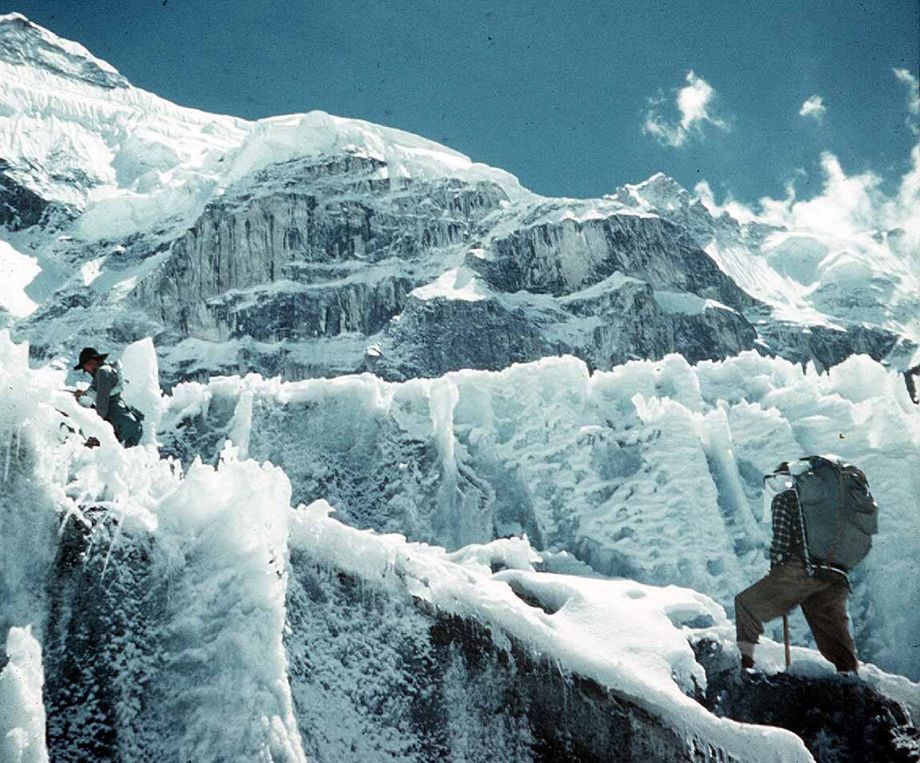 Hans-Peter Duttle climbing the Nup La, heavily laden. Hans-Peter Duttle
Hans-Peter Duttle climbing the Nup La, heavily laden. Hans-Peter Duttle
On the way to base camp
February 26, 1962, departure from Boston. In Geneva, meeting with guide Raymond Lambert. Far from discouraging them, the legendary mountaineer of the two Swiss expeditions of 1952 gave them a warm welcome. The Lambert garage becomes the Swiss base camp. Symbolic torch: Raymond lends them his large tent used at Everest base camp.
Roger Hart, tired of the preparations, goes skiing in Zermatt. On the ski slopes, he meets 24-year-old schoolteacher Hans Peter Duttle. A few days later, despite his lack of mountaineering experience, Hans agreed to follow them on their adventure. Being close in age to Roger Hart, Hans Peter Duttle balanced the group.
Finally, on March 26, they land in Kathmandu. They recruited the porters needed to cover the 250 km from the terminus of the motorized track to the Gyachung Kang base camp. KC, the liaison officer imposed by the Nepalese authorities, is the main concern. If he got wind of their project, everything would fall apart. The "trek" (then known as the approach march) went off without a hitch, apart from a few stormy encounters with yaks allergic to Western smells. Namche Bazar, Phortse, Gokyo valley. On April 24, they set up base camp. The porters leave. Three Sherpas and the liaison officer remain.
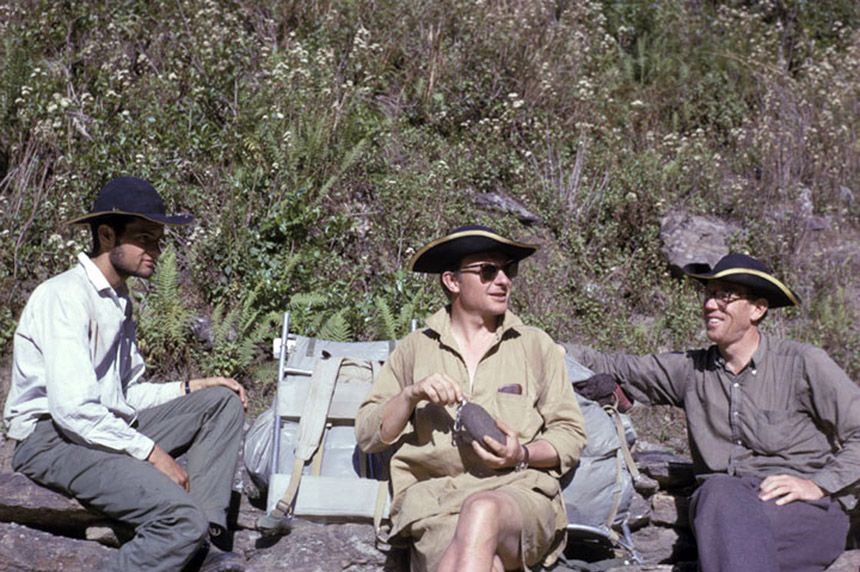 Roger Hart, Norman Hansen and Woodrow Wilson Sayre relaxed and clean-shaven
Roger Hart, Norman Hansen and Woodrow Wilson Sayre relaxed and clean-shaven
© Hans-Peter Duttle 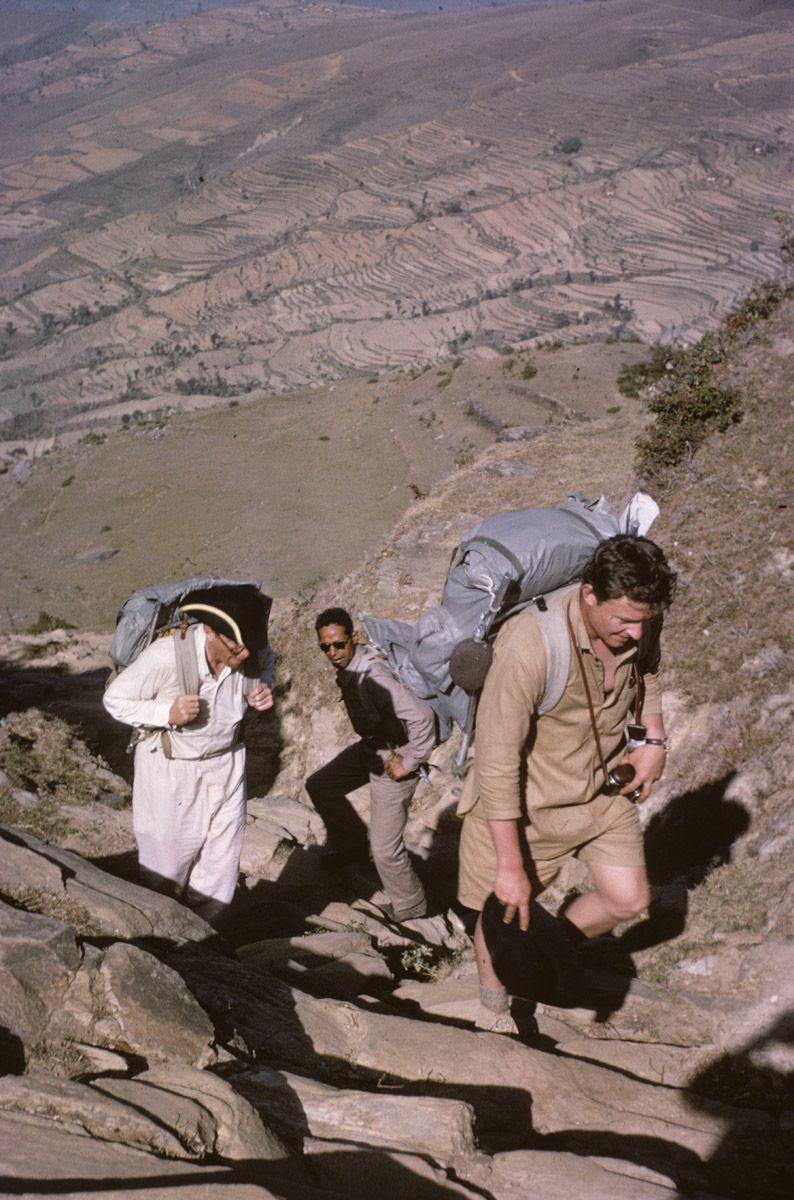
Base camp walk © Hans-Peter Duttle
In the thick of things
Here they are at last. First technical difficulties. Two large serac bars cut across the Ngo Jumbo glacier, which they had to climb for five kilometers and nine hundred metres to reach the Nup La pass. Fortunately for them, the liaison officer remains at base camp. Wilson Sayre and Roger Hart struggle over the two obstacles: it will take them fourteen days of stubborn effort. The Sherpas climb with the loads and turn around at the top of the second serac bar (5,800 m), to return to base camp. With the liaison officer, they set off again for Khumjung, a village perched high above Namche Bazar. KC will stay on to bask in the sun, while the Sherpas return to work in the Khumbu. They'll be back at camp together later, waiting for them. The appointment is made for June 1st. Phew! With the liaison officer out of the way, the team, free to move about, hurries over the pass.
May 9, 1962. This is when their insane adventure really begins. Each stage had to be covered twice with 18 kg bags to carry all the equipment and, above all, food. Establish food caches for the return journey. Crows and other predators are quick to raid them.
Descent of the western Rongbuk glacier, crossing of the main glacier, ascent of the eastern Rongbuk glacier. Endless detours between ice penitents, at the foot of which stretches of more or less frozen water form traps that must be avoided. Their only meals were dried meat bars and lots of sugar. In 19 days, they covered 40 kilometers of moraines to reach the foot of the North Col at 6,500 m. Tired, but full of enthusiasm. They believe in their summit. Victory seems within their grasp.
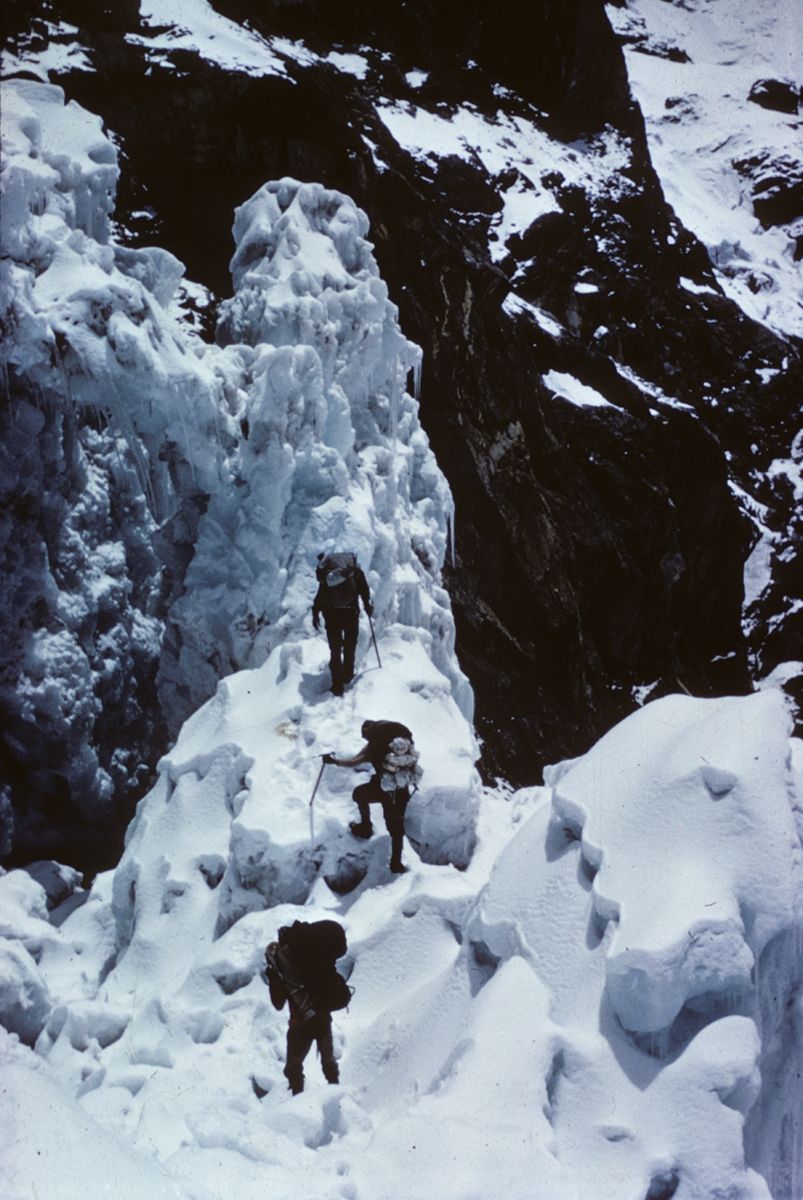 Difficult climb to Nup La © Hans-Peter Duttle
Difficult climb to Nup La © Hans-Peter Duttle
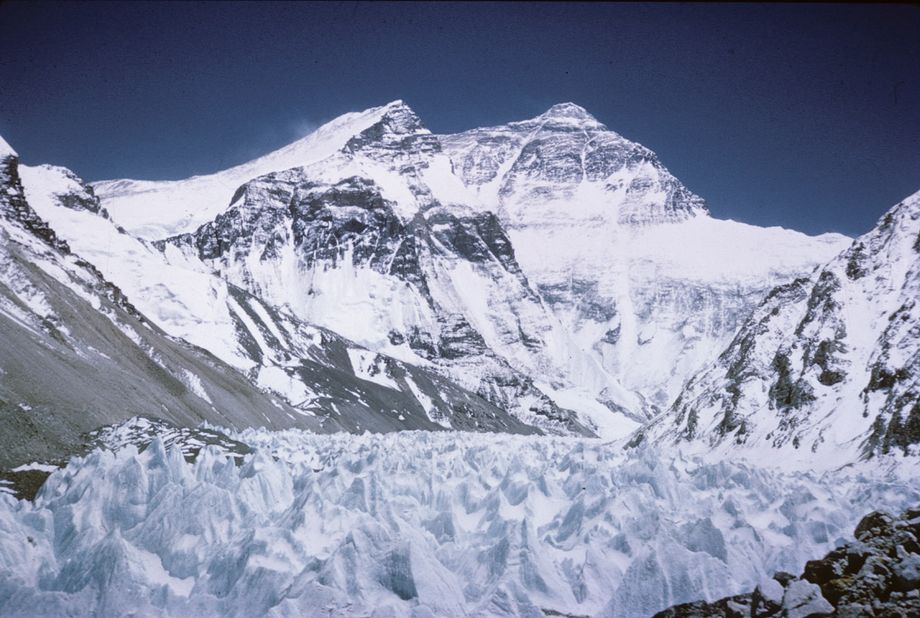
Labyrinth of ice penitents © Hans-Peter Duttle
The North Col
May 29: they climb the steep slopes leading to the North Col. In the lower third, a wide crevasse blocks the way. British expeditions in the thirties had already had trouble overcoming this obstacle. A providential boulder stuck in a precarious position allowed Sayre to cross. A perilous climb follows to reach the upper lip of the crevasse, where they set up a cache of food and equipment. Back to camp at the foot of the pass.
May 30: late start (tiredness starting to show). Camp uncomfortable at crevasse level.
May 31: with 22 kilos each, they climb the last 400 metres to the North Col: 7,010 m! Wilson Sayre: "Then, all of a sudden, I took the step I'd been dreaming of for twenty years. I was treading the crest of Everest's North Col."
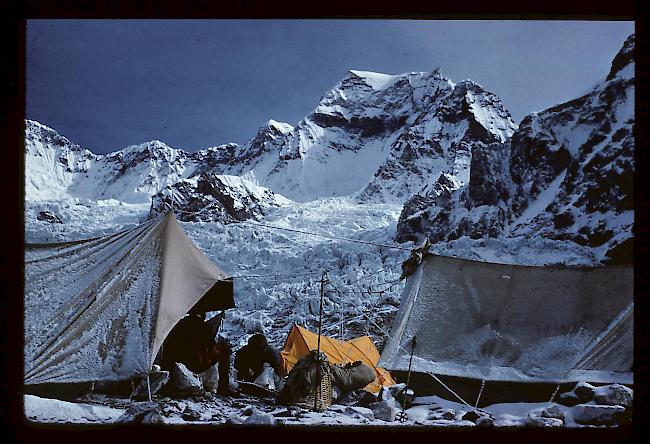
Base camp at 6,000 metres © Hans-Peter Duttle
The fall
Despite their fatigue, Wilson and Roger go down to get the packs left near the crevasse. A fateful mistake. The exhausting ascent takes place in the twilight. Suddenly, drama. Roger slips, dragging Wilson with him. Miraculously, the fall stops. Nothing broken, but a few bruises.
6,900 m, it's dark, they have no sleeping bag, no stove, no food. Hours go by. Roger is more or less delirious. But they survive. The next day, they reach the North Col, where Norman and Hans Peter, worried sick, welcome them with relief.
June 2: despite the terrible misadventure of the previous day, they are determined to continue the climb. Wilson Sayre, less exhausted than Roger Hart, set off with Norman Hansen. In two days, they painstakingly climbed 350 m. Last camp at 7350 m. On the third day, Wilson set off again alone. He would at least like to reach the band of yellow rocks (8,200 m!). Exhausted, he probably stops at 7750 m. A chaotic return to the last camp. An attempt to climb down ends in a vertiginous slide that ends abruptly in some providential rocks. New bruises, but no breakage!
(1).jpg) Roger Hart battling the sun, the group didn't pack any sun cream © Hans-Peter Duttle
Roger Hart battling the sun, the group didn't pack any sun cream © Hans-Peter Duttle
Survive or perish
On June 5, the whole team was back together at the North Col. The long, long way back lies ahead. With the monsoon and its afternoon snowfalls looming large. The descent from the North Col turned into a nightmare. They accumulated clumsiness and technical errors in their belaying. New falls and slips, all of which could have been fatal. The humor with which Wilson narrates these dangerous glides remains a great moment in Himalayan literature. A total of 330 meters of falls, a real record. Night catches them just a few hundred meters from the rescue camp. A new improvised bivouac under the stars.
From June 7 to June 17, back to base camp. Snow hides the food caches. With an ice axe for four, we have to make our way through the labyrinth of ice penitents. Finally, the Nup La. Back to Nepal. In a hail of falling rocks, they abseil down the seracs they had climbed before. Once again, they escape unscathed.
.jpg) Sayre, exhausted © Hans-Peter Duttle
Sayre, exhausted © Hans-Peter Duttle
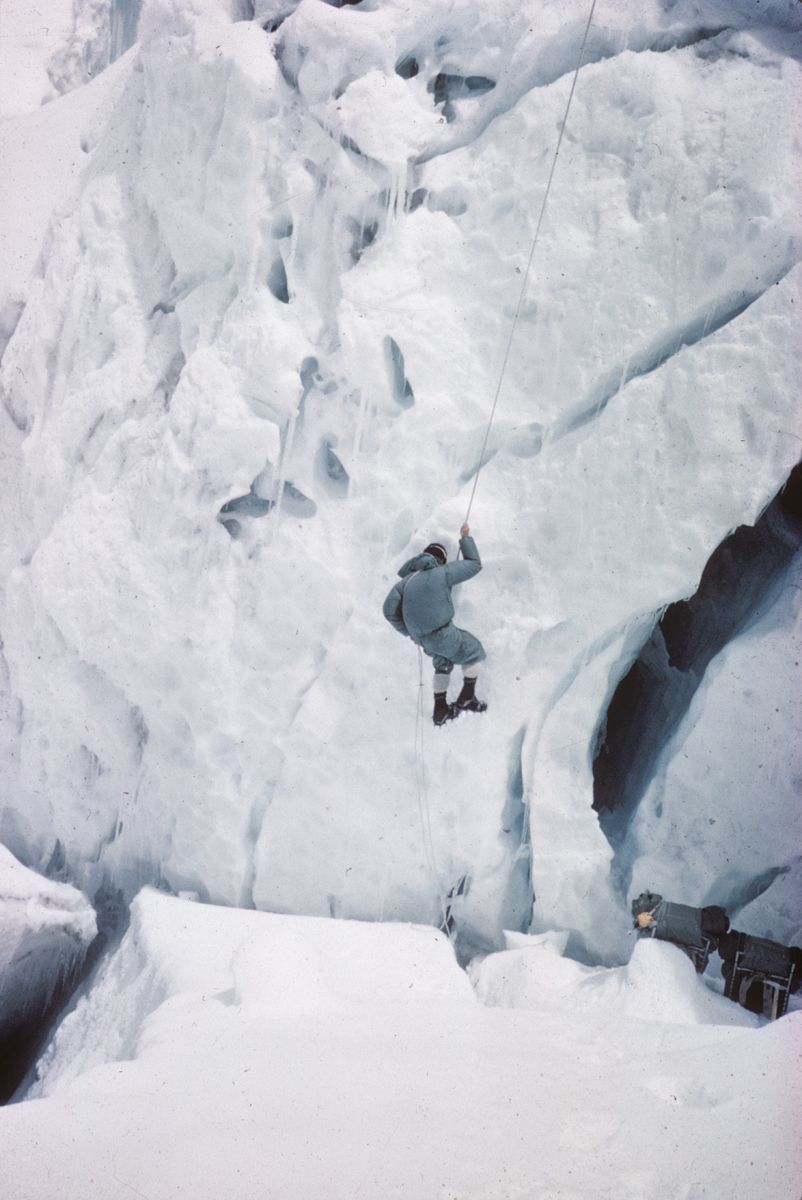
Abseiling © Hans-Peter Duttle
The liaison officer has packed his bags
Exhausted, but alive, they arrive at base camp. Sayre: "In 13 days, we had to ration 9 times. Five days without meat, 3 without sugar". An unpleasant surprise. On a single post, a note from KC, the liaison officer. On June 9, no doubt tired of waiting, he ordered the Sherpas to break camp. Bad weather and lack of food forced him to take this decision, he explains. On June 18, fifteen hours of arduous walking on empty stomachs enabled them to finally reach the first inhabited hamlet.
Saved! Each of them had lost some 15 kilos.
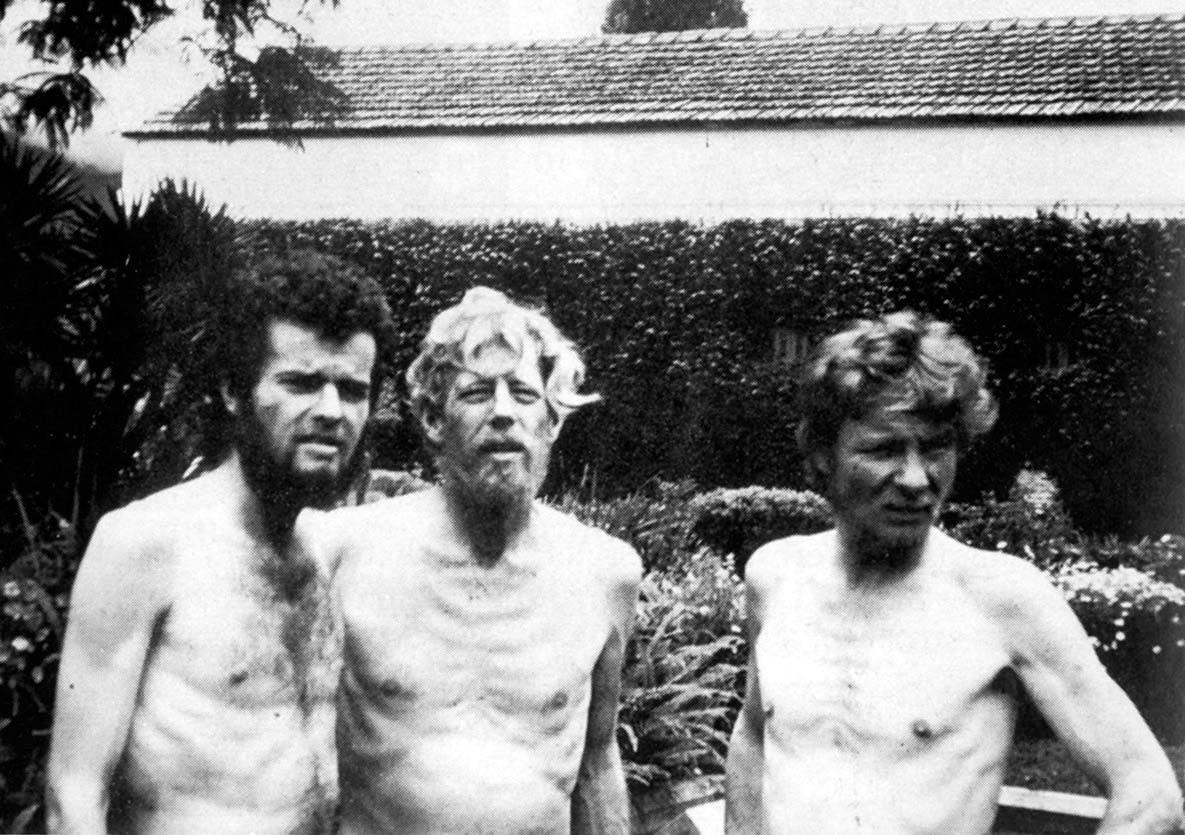 Roger Hart, Wilson Sayre and Norman Hansen in Kathmandu hospital on their return
Roger Hart, Wilson Sayre and Norman Hansen in Kathmandu hospital on their return
© Hans-Peter Duttle
Mais l’annonce de leur disparition est parvenue aux USA. Leur retour inespéré fait sensation.
Norrman Dyrenfurth, present in Kathmandu to prepare his expedition for the following spring, came in person to join them in Khumjung by helicopter. He was happy to see them alive, but very worried about the diplomatic consequences of their clandestine adventure. The Chinese Communists would be furious and put pressure on the Nepalese government. The official American expedition of 1963 might well be cancelled altogether.
The return home took an unexpected form. The State Department is lobbying to prevent the publication of the expedition's story in Life magazine. What if the Chinese accused America of sending spies to Tibet? A real affair of state, of little use to President Kennedy.
Almost unnoticed (and for good reason), this expedition, a model of lightness and independence, foreshadowed that of Reinhold Messner and Peter Habeler who, on May 8 1978, reached the summit of Everest via the Nepalese side without oxygen. On August 20, 1980, Messner climbed the North Face solo, still without oxygen.
Let's leave the last word to the great Eric Shipton, apostle of lightweight expeditions:
"The mere fact that you got this far on this long and arduous route, with the meagre resources at your disposal, is in itself a remarkable feat. And I sincerely regret that your misfortune at the North Col deprived you of a victory to which you were entitled".
Join the next Everest climb via the Nepalese South Face or the North Tibet side.
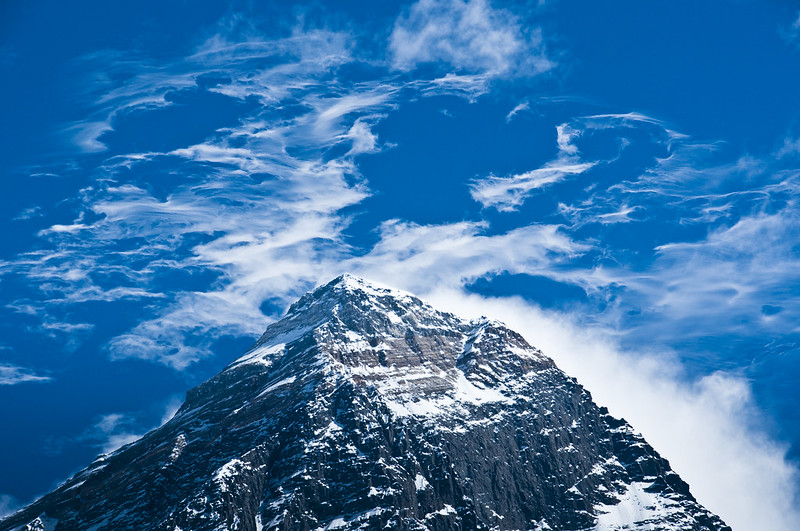
Mount Everest from Kala Pattar, Nepal © David Ducoin
Text by Didier Mille.
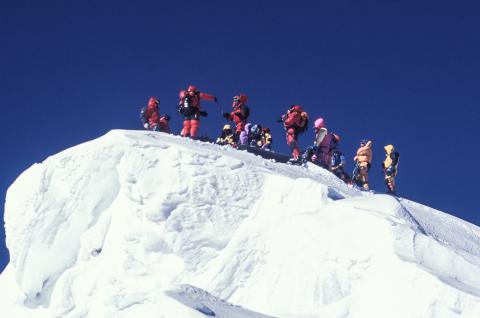
Climb mount Everest at 8849 meters North Tibet side
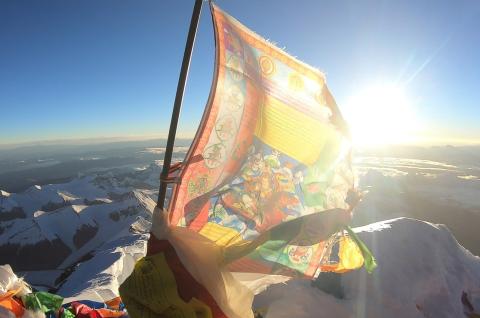
Climb mount Everest at 8849 meters South Nepal side
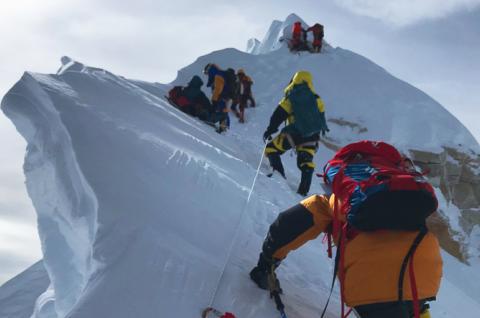

 Expeditions Unlimited blog
Expeditions Unlimited blog